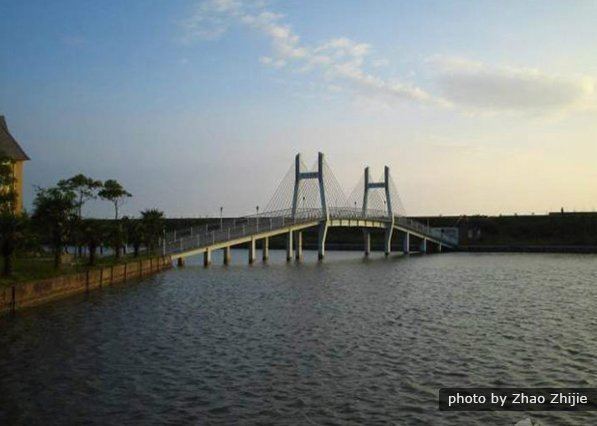Traditional Chinese 橫沙島 Literal meaning Heng Sands Island Traditional Chinese 橫沙鄉 | Simplified Chinese 横沙岛 Hanyu Pinyin Simplified Chinese 横沙乡 | |
 | ||
Hengsha is a low-lying alluvial island at the mouth of the Yangtze River in eastern China. Together with the islands of Chongming and Changxing, it forms Chongming County, the northernmost area of the provincial-level municipality of Shanghai. Its population was 33,400 in 2008.
Contents
- Map of China Shanghai Chongming E6A8AAE6B299E5B29B
- Name
- History
- Geography
- Economy
- Government
- Infrastructure
- In popular culture
- References
Map of China, Shanghai, Chongming, %E6%A8%AA%E6%B2%99%E5%B2%9B
Name
Heng is the horizontal, rightward stroke ⟨一⟩ used in writing Chinese characters, similar in form to a dash. It is also used to mean "horizontal". It was applied to the island for the way it formerly stood athwart the mouth of the Yangtze, although time has now given it a round or heart-like shape and moved it in line with Changxing.
History
Hengsha first emerged from the Yangtze in 1858. It began to be reclaimed for agricultural purposes in 1886 or 1890. Hengsha Township was established in 1909. Between its formation and 1958, the island gradually expanded towards the northwest while receding to the southeast: together, these actions caused the island to "migrate" about 5.25 kilometers (3.3 mi) in the direction of Changxing. Under the Republic, the island carried on an active trade in grains via junk.
Hengsha was originally part of Chuansha County, which later merged into Pudong. In 1958, the island was placed under Baoshan County, as its ferries operated from the harbor of Wusong at the mouth of the Huangpu. The island's wandering was ended by the erection of a seawall and stabilization of the banks around the island. The next year, it saw a major influx of population, including boat people who were organized into fishing brigades. During the Down to the Countryside Movement, many of the sent-down youth from Shanghai travelled no further than Hengsha, where they assisted in reclamation, urban defense, and propaganda efforts.
Hengsha was named among the first set of national tourist resorts (t 國家級旅遊度假村, s 国家级旅游度假村, p guójiā jí lǚyóu dùjià cūn) by Beijing in October 1992. Initial plans called for the construction of a casino, although that was cancelled. In March 2002, the Shanghai Municipal Government approved plans to develop Hengsha as an international conference center and forest park, with tree coverage over at least 70% of the island. In 2005, it was moved from the jurisdiction of Baoshan District to Chongming County.
Geography
Hengsha is located in the channel of the Yangtze River flowing south of Chongming and north of the districts of Baoshan and Pudong immediately before its entrance into the East China Sea. Hengsha is the southeastern-most of the three islands of Chongming County, separated from Changxing to its west by the Hengsha Xiaogang Channel.
Hengsha is fairly round, with a height north-to-south of about 10 kilometers (6.2 mi) and a breadth east-to-west of about 8 kilometers (5.0 mi). Constantly expanding, it covered about 56 square kilometers (22 sq mi) in 2010 and had an average elevation of 2.87 meters (9 ft 5 in).
Economy
The orchards of Hengsha are the center for Shanghai's production of citrus fruits. Other crops include rice, cotton, and rape. Both freshwater and marine fishing are practiced, principally landing two kinds of anchovy. The island is also being developed for ecotourism and high-end resorts, including an international conference center, communities of low-density luxury villas, and yacht clubs.
One of Shanghai's commercial cemeteries is located on the island and the Hengsha Xiaogang Channel is also used for sea burials and the dispersing of ashes.
Government
Hengsha is administered as a single township, also named Hengsha. This is divided into 24 villages, including one fishing village. The main settlement is at Xinmin (新民居委会, Xīnmín Jūwěihuì). The others are:
Infrastructure
Unlike Chongming and Changxing, Hengsha remains connected to the rest of Shanghai only by ferry service. There are plans for a small airport to be constructed.
In popular culture
Hengsha is one of the main settings of the 2011 video game Deus Ex: Human Revolution, in which it is depicted as a major city.
